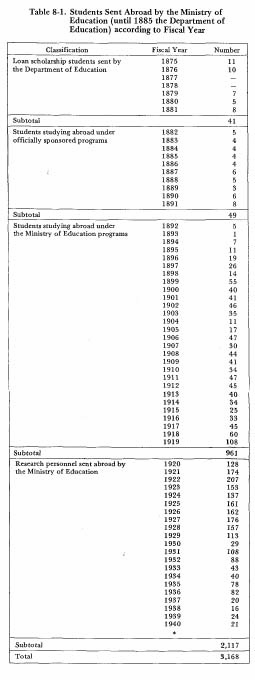- 現在位置
- トップ > 白書・統計・出版物 > 白書 > JAPAN'S MODERN EDUCATIONAL SYSTEM > (2)International Cultural Exchange in the Prewar Period
(2)International Cultural Exchange in the Prewar Period
In their efforts to absorb European and American culture, the leaders of the Meiji Restoration enthusiastically promoted activities such as the sending of top-level leaders to foreign countries, the dispatch of students to study abroad, the employment of foreigners, and the translation of foreign scientific books into Japanese. These policies were continued throughout the Meiji, Taisho, and into the middle of the Showa era, contributing greatly to the development of Japanese culture. Simultaneously, the introduction of Japanese culture abroad was pursued through participation in the World Expositions held in Paris in 1867 just before the Meiji Restoration, in Vienna in 1873, in Philadelphia in 1876, and again in Paris in1878. Japan was also represented at the World Religious Conference held in conjunction with the World Exposition in Chicago111 1893. In the twentieth century, exhibitions of Japanese fine arts toured six American cities in 1921, and were sent to France and Austria in 1922. However, until the 192Os, the role of the Ministry of Education in international activities was negligible except for the selection of students to study abroad. Japanese students interested in science had begun to study in Europe and America in the last years of the Edo period. The Meiji government adopted a much more positive policy in this respect and the number of students sent to the United States alone between 1868 and 1872 numbered some 500. The selection of students to go abroad was initially somewhat haphazard, but with the establishment of the Department of Education in 1871 some order was introduced. By 1875 a formal selection process was established and the exchange students were awarded loan scholarships by the Department of Education. This system was maintained until the outbreak of the Pacific War (1941 -1945), although there were many changes in the administrative details.
The countries to which most students have been sent since the Meiji era are the United States, England, France, and Germany; the major fields of study include law, economics, physics, chemistry, engineering, and medicine. The number of students sent abroad between 1875 and 1940 exceeded 3,000 (See Table 8-1.).
Table 8-1. Students Sent Abroad by the Ministry of Education (until 1885 the Department of Education) according to Fiscal Year

The students sent abroad by the government, especially in the early Meiji era, were handpicked as especially promising scholars capable of replacing the foreign teachers in the higher educational institutes or of becoming leaders in other circles. Among these men, many indeed went on to form the nucleus of the nation's leadership and to play an important role in the construction of the modern state. The number of foreigners of all nationalities employed by the Meiji government agencies in 18 72 totaled 214 according to one government list. By nationality these persons came from the following countries: England, 119; France, 50; the United States, sixteen; China (Ch'ing dynasty), nine; Germany, eight; Malaya, four; Holland, two; India, two; Italy, one; Belgium, one; Portugal, one; and Denmark, one. The number of foreigners employed by the Department of Education alone totaled 72 in 1875. Their contribution was considerable. While the number of foreigners employed by the government decreased as the students who had been studying abroad began to return to Japan, the numbers gradually increased again in the last years of the 1880s.The number of foreign students studying in Japan has grown gradually since the end of the nineteenth century. Regulations for the Special Admittance of Foreign Students into School sunder the Direct Control of the Ministry of Education were issued in November, 1901. Regulations concerning Local Public and Private Schools Admitting Chinese Students under the Ch'ing Dynasty were issued in November, 1905, at which time approximately 10,000 Chinese students were studying in Japan. The process of importing scientific books from Europe and America was speeded by the sending of students abroad, the employment of foreigners by government agencies, universities and the like. The Department of Education undertook the task of translating, editing, and publishing many of these books. By1874, 51 works totaling 132 volumes had been issued. This work was all the more significant because in the act of translating scientific works, tens of thousands of technical terms in all fields - philosophy, law, economics, psychology, physics, and chemistry among others - were either created or standardized. The translation of scientific books had important ramifications for the overall development of education, science, and culture.
お問合せ先
(C)COPYRIGHT Ministry of Education, Culture, Sports, Science and Technology
-- 登録:平成21年以前 --